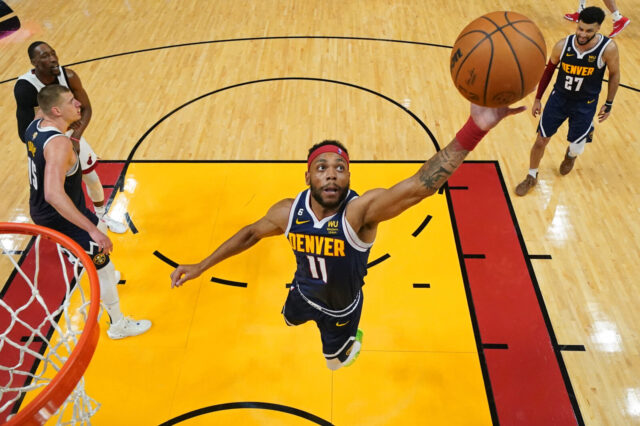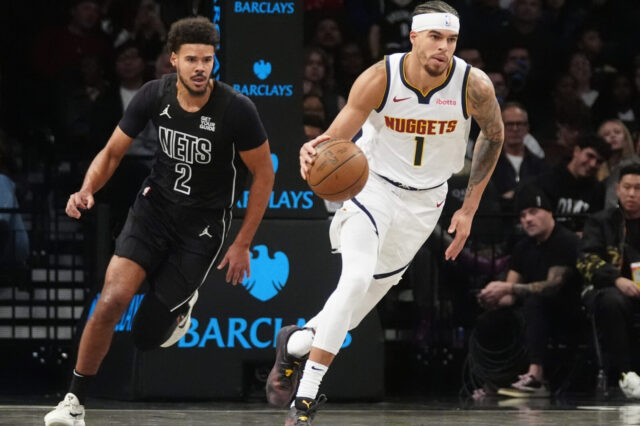If you’re not familiar with Film Fridays, each Friday, I’ll be looking at some recent Denver Nuggets’ games, lineups or something else from a film aspect to try and bring you a piece of content that you’re not getting somewhere else. Feel free to give any feedback positive or negative in the comments or find me on Twitter.
In April of this year, Jamal Murray was lost for the remainder of the season with a torn ACL. This came shortly after the team had traded for forward Aaron Gordon, and they were looking like one of the best teams in the league and a legitimate threat to win the title. We all know how the rest of the season went. The Nuggets’ guards were bit hard by the injury bug, and that ultimately was their downfall at the end of the season.
On average, NBA players take around 11 months to fully recover and return from their injury with some being earlier or later depending on how well their rehab goes. This would put Murray back on the court in March of 2022 assuming that he’s right on schedule. For one, I think he’s back sooner than that just based on the clips that we’ve seen from him so far. Regardless, what can we expect from Murray when he does come back? That’s what we’re looking at today.
Murray was one of the NBA’s best point guards prior to his injury. His ability to create his own shot at all levels along with his budding skills as a defender and distributor had him preparing to take the next jump into the tier above him. Watching him battle against Chris Paul, Damian Lillard and Devin Booker in the playoffs would have been incredible. Now, coming off of the torn ACL, what could we be seeing?
Less Slashing with More Jumpshots
Murray should get his burst back after he gets back up to game speed, but, upon his initial return, plays like this are likely going to be less frequent. Murray gets Kent Bazemore off balance out near the 3-point line because Bazemore has to be ready for Murray to rise up for the jumper. With Bazemore out of position, Murray has the burst to get by him and to the rim. Until that burst fully returns, this is an area of his game that will likely be less frequent.
More than likely, we’ll be seeing a lot of plays like this. Murray is on the bigger end of the spectrum in terms of point guards, and he tends to play like that at times when he’s hunting a jump shot. On this play, he’s being guarded by Marcus Morris out near the 3-point line. He has the shot clock winding down, and, rather than trying to use finesse to create separation, he just goes to his spot and rises up for the jump shot. Thankfully, Murray’s mid-range jumper is one of the best aspects of his game, because he will likely be targeting that area of the floor frequently when he comes back.
Defense Could Regress
Prior to last season, Murray was viewed as a negative on the defensive end. He focused hard on the offensive end of the floor, but he was starting to show his development on the other end prior to his injury during the 2020-21 season. During the team’s loss to the Boston Celtics in February, Murray took it upon himself to check star forward Jayson Tatum. At 6’8”, Tatum has five inches of height on Murray, but that didn’t deter Murray from taking on that role his team needed from him. Murray slides his feet to stay in front of him as Tatum is driving to the basket. When Tatum initiates contact to generate separation, Murray does a great job of avoiding the foul while still putting up a contest and forcing the miss.
This is an example of a play that Murray will likely show with consistency when he returns. His lateral mobility is not the best, and he struggles to keep himself in front of Norman Powell who’s driving to the basket. Murray receives a slight screen from Marc Gasol, but that shouldn’t be enough to deter him heavily. When Murray comes back, assuming his lateral mobility needs time to get up to full speed, he’ll need more help from his teammates, or he’ll need to shade differently to guard his assignments. We could ultimately see him switching onto assignments that are less likely to force him to move side-to-side.
Load Management Inbound
In recent years, NBA teams have worked to cut back the minutes for their star players when they’ve been able to. This was the first season in Murray’s career where he had been averaging more than 32.6 minutes per game. Next season, he likely will end up around the 30 minutes per game mark, and performances like this one against the Utah Jazz are much less likely. This is Murray’s final bucket from his 36-point performance from Game 1. He had played 40 minutes in the game, and his legs were dead tired to this point in the game. He’ll still be in for pivotal moments next season, but it’s more likely that we’ll see him more sparingly during the minutes in the middle quarters.
Here’s an example of the tired legs coming into play. This was Murray’s penultimate possession from this past season. He is driving to his left towards the basket, and he doesn’t have the burst that you’re used to seeing from him. Murray was in his 33rd minute of play after missing the previous four contests nursing another injury. Murray is able to go and get a shot up because of his size and offensive skill, but he just doesn’t have the lift that he did in the first quarter of that game.
For those of you that are still here, remember to leave your feedback in the comments or over on my Twitter, and have a fantastic film-filled Friday.


